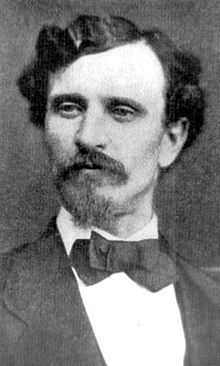John M. Clayton (Arkansas)
| John M. Clayton | |
|---|---|
 | |
| John Middleton Clayton | |
| United States House of Representatives | |
| Personal details | |
| Born | October 13, 1840 Chester, Pennsylvania, U.S. |
| Died | January 29, 1889 (aged 48) Conway County, Arkansas, U.S. |
| Resting place | Bellwood Cemetery |
| Political party | Republican |
John Middleton Clayton (October 13, 1840 – January 29, 1889) was a Republican Congressman-elect in post-Civil War Arkansas. He may be best remembered for his mysterious assassination in 1889. The identity of his assassin remains unknown.
Biography
Clayton and his twin brother, William (W.H.H. Clayton), were born on a farm near Chester, Pennsylvania to John and Ann Glover Clayton. His father was an orchard keeper and carpenter. His parents had ten children in all, although six died in infancy. Clayton went on to marry a woman named Sarah Ann with whom he had six children. During the Civil War, he served in the Army of the Potomac where he engaged in several campaigns in the east. In 1867, he and his family moved to Arkansas where he managed a plantation owned by older brother, Powell Clayton, who would become the Governor of Arkansas the next year.
In 1871, Clayton was elected to the Arkansas House of Representatives representing Jefferson County, his brother, Powell, starting his term in the United States Senate the same year. In 1873, he served in the Arkansas Senate representing Jefferson, Bradley, Grant and Lincoln Counties, also serving as Speaker of the Senate pro tempore for part of his term. He served on the first board of trustees of Arkansas Industrial University, today the University of Arkansas, when it was chartered in 1871. Two years later, Clayton helped Pine Bluff, Arkansas secure the Branch Normal College, today the University of Arkansas at Pine Bluff. He became involved in the Brooks-Baxter War of 1874 which was fought over the disputed election for the governor's office between Joseph Brooks and Elisha Baxter. Clayton, a supporter of Brooks', raised troops in Jefferson County and marched them to Little Rock, Arkansas where they fought Baxter supporters. He remained loyal to Brooks to the end of the conflict when President Ulysses S. Grant declared Baxter the rightful governor.
Clayton remained involved in Arkansas politics in the years after Reconstruction. With the support of black Republican voters, he became sheriff of Jefferson County in 1876, being reelected to five successive, two year terms. In 1888, he ran to represent Arkansas's 2nd congressional district in the United States House of Representatives, going up against incumbent Democrat Clifton R. Breckinridge. The election became one of the most fraudulent in Arkansas' history. Clayton lost the election by a narrow margin of 846 out of over 34,000 votes cast. However, in one case in Conway County, four masked and armed white men stormed into a predominately black voting precinct and, at gunpoint, stole the ballot box that contained a large majority of votes for Clayton. Losing under such circumstances, Clayton decided to contest the election and went to Plumerville, Arkansas to start an investigation on the matter. On the evening of January 29, 1889, an unknown assailant shot through the window to the room he was staying in at a local boardinghouse and killed him instantly. He was later declared the winner of the election and Breckinridge was unseated and the seat declared vacant. His assassin was never found.
Clayton was interred in Bellwood Cemetery in Pine Bluff, Arkansas.
References
- Barnes, Kenneth C. Who Killed John Clayton? Political Violence and the Emergence of the New South, 1861–1893. Durham, N.C.: Duke University Press, 1998.
External links
- "John M. Clayton". Find a Grave. Retrieved 2008-10-17.
| United States House of Representatives | ||
|---|---|---|
| Preceded by Clifton R. Breckinridge |
Member of the U.S. House of Representatives from Arkansas's 2nd congressional district declared winner after death |
Succeeded by Clifton R. Breckinridge |
|